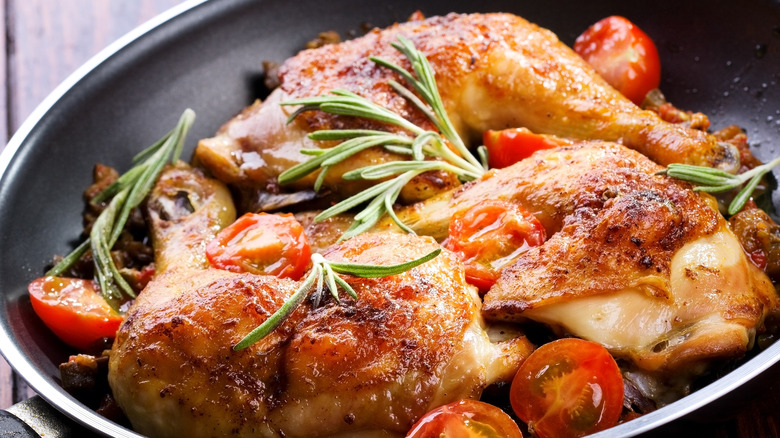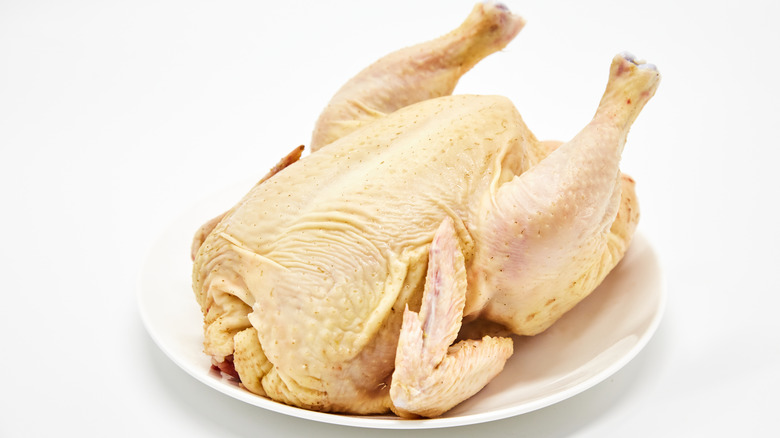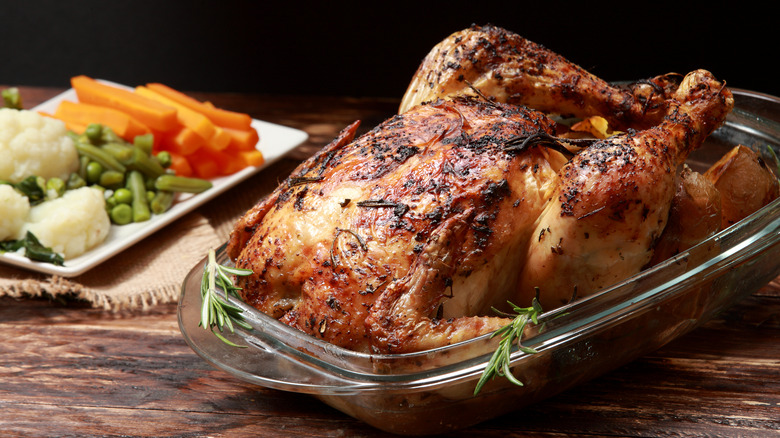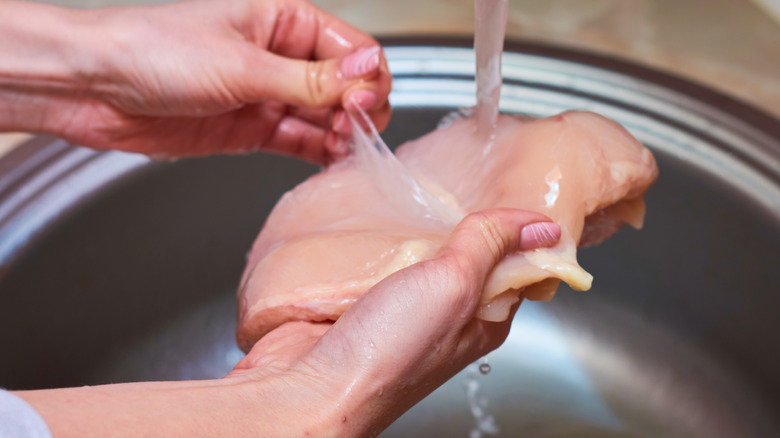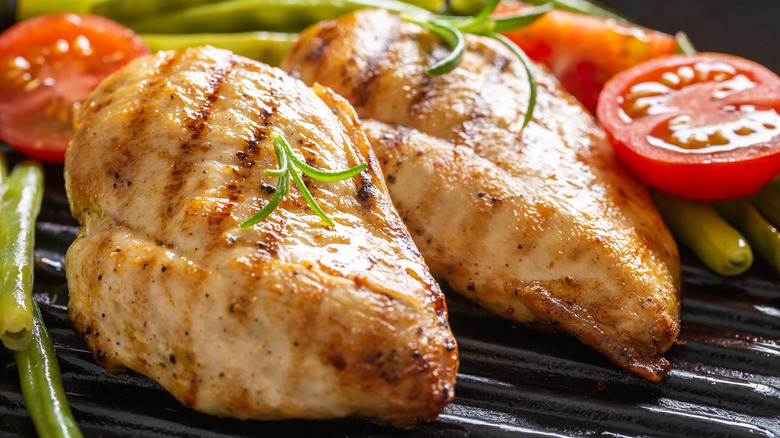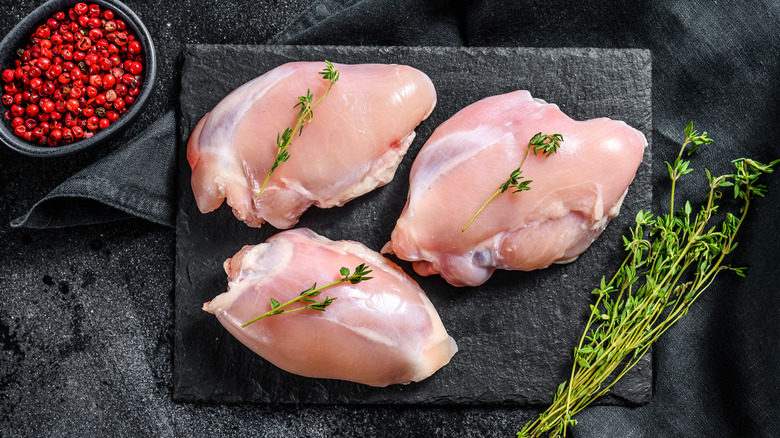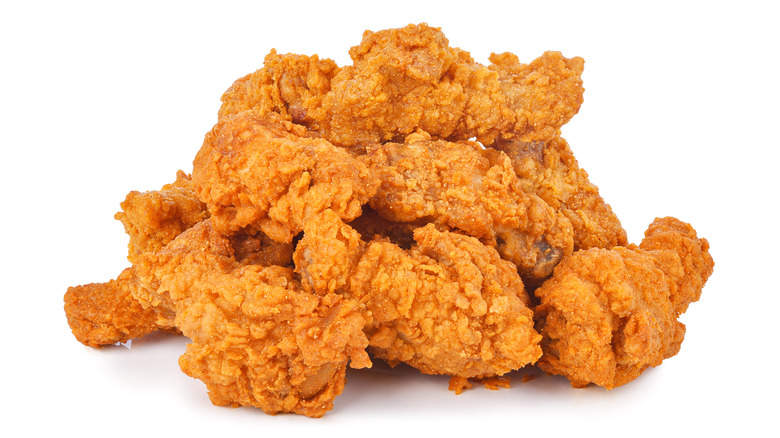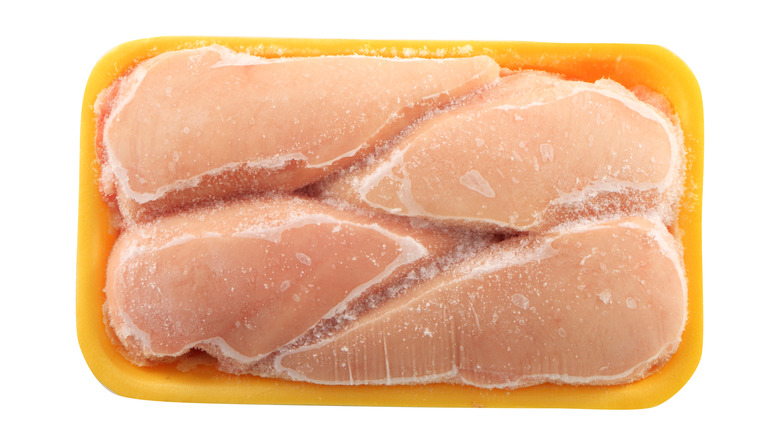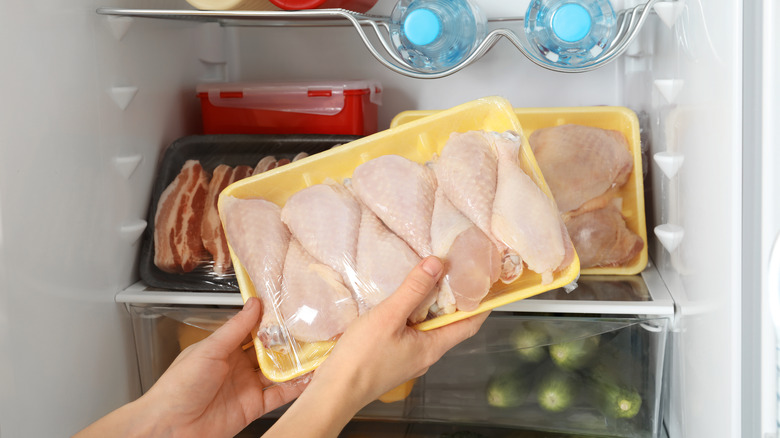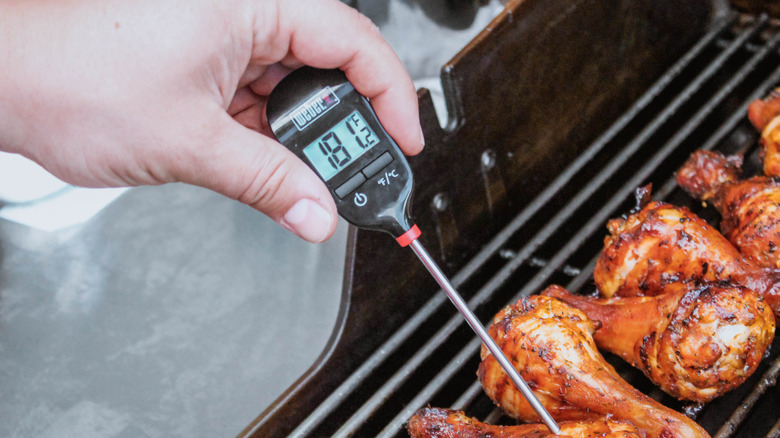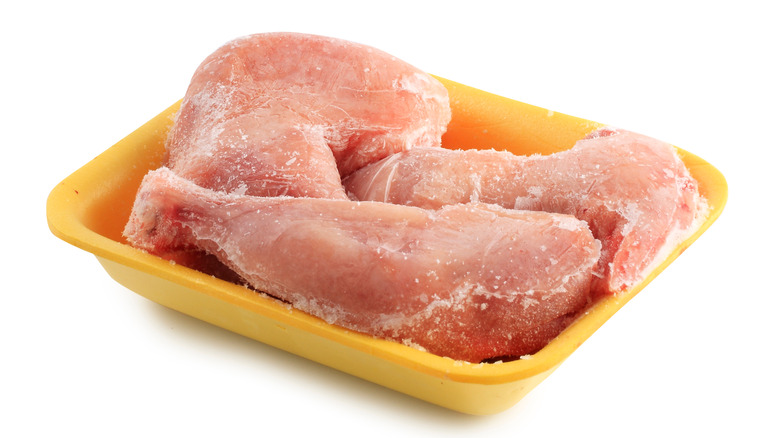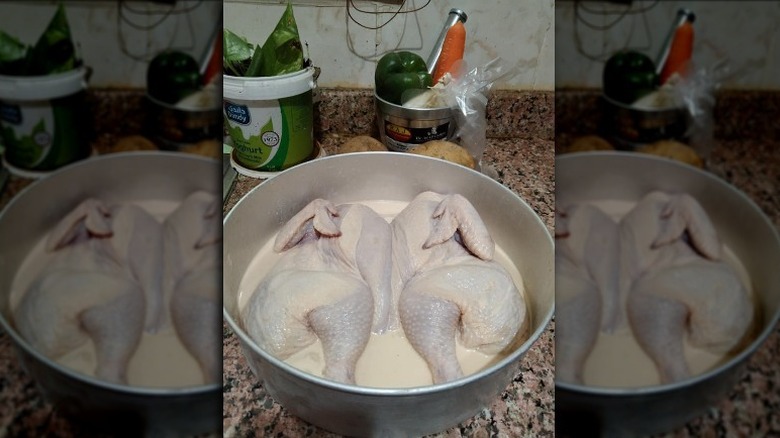12 Myths About Cooking Chicken You Should Stop Believing
If there's one kind of meat that pretty much everyone can get on board with (except you, vegetarians), it's chicken. Think about it: Not everyone likes beef or pork, but chicken is often thought of as a blank slate that can pair well with anything. We don't disagree. But while ordering the chicken at a restaurant is always a safe bet, what about when it comes to cooking chicken in your own kitchen? If you've ever attempted and failed at recreating a chicken recipe, then you know that it's not always as simple as it looks.
All that trouble partially comes from ideas about what cooking chicken really involves. However, there are a lot of people out there who believe prevalent chicken myths — ideas about cooking chicken that are actually just false. So, how do you know that you're cooking your chicken the right way and not falling victim to these common myths?
Well, we wanted to clear some of the confusion up for you, so we've compiled a list of some of the most common — and the most egregious — chicken-cooking myths. That way, the next time you plan on cooking chicken at home, you'll have a better idea of how to cook your chicken to perfection. The more you know, the better. Let's take a closer look at some of these common chicken myths.
1. You shouldn't cook with — or eat — chicken skin
When you buy a whole chicken to cook with, it can seem kind of intimidating. After all, it's not exactly the same thing as a package of chicken breasts — there are more parts you have to think about, which can make the task daunting. But one common mistake that home cooks make when they start cooking their chicken is removing the skin. This may seem like a good idea because it'll cut down on the fat content, but we're here to tell you that removing the skin is the last thing you'll actually want to do.
It turns out that, per The Daily Meal, leaving the chicken skin on is actually the best move you could make. First of all, it's going to provide your chicken with a lot more fat and flavoring, which is exactly what you want when you're trying to cook a delicious chicken. And that fat is actually good for you: It's unsaturated fat, which has been shown to lower cholesterol. Plus, when you take advantage of all the flavor from the skin, you won't need to bread your chicken to get that amazing flavor you're going for.
Plus, removing the skin can be a big hassle, so it's definitely a plus that you get to skip this step. Moral of the story? There's not a great reason to remove the skin from your chicken.
2. Roast chicken shouldn't be a weeknight thing
Thinking about roasting a chicken? Roast chicken makes a delicious meal, and you can use the leftovers for all kinds of uses. However, roasting a chicken can seem like a lengthy process. Therefore, it may not seem ideal for a weeknight project. However, you may be surprised to find out that the roast chicken dinner of your dreams can totally be a reality even on weeknights.
According to The Kitchn, roasting a chicken during the week is totally manageable. Instead of choosing a large chicken, though, you should go for one that's on the smaller side. That will allow for less cooking time so you can get dinner on the table faster. The Kitchn says that a small chicken will only take about an hour to roast. Yes, you heard that right. While the prep work does take some effort, just one hour in the oven doesn't seem like a long time to wait to enjoy a delicious roast chicken on a random Tuesday. So go ahead, treat yourself and your family to something a little special!
3. It's important to wash your chicken before you start cooking
Are you the kind of person who always washes their chicken? If you are, you're not alone. Many swear that it's important to give your chicken a solid rinse under the kitchen sink before starting to cook. However, washing your chicken is totally unnecessary. In fact, it may cause even more problems than it solves.
According to the USDA, while washing meat was once important and common practice, that's no longer the case. That's because meat is well-cleaned before it even makes it into a package and into your grocery store. Therefore, taking this step is totally unnecessary.
You may still feel like you're being cleaner by washing your chicken, and that's definitely not the case. Actually, you could be putting yourself at increased risk of food-borne infection. Why? When you rinse your chicken, you're spreading bacteria around your kitchen: into your sink, around your counter, and onto any dishes or utensils you use. This can result in cross-contamination. If you don't clean exceptionally well after doing this, you could be exposing yourself or your family to the harmful bacteria you were just trying to avoid.
So, take it easy and make things simpler — and safer — for yourself by skipping the part where you wash your chicken.
4. The breasts are the best cut
Reading some recipes, you might assume that the best cut of chicken is the breast. And okay, we get the appeal. It's an easy cut of meat to work with, and it can be added to a lot of different dishes. Plus, it's leaner, which may help some people feel better about not eating too much fat. But we have to be honest: If you're looking for flavor and tenderness, the breast is generally not the way to go. Because this cut isn't very fatty, it's super easy to end up with dry hunks of chicken that make your dish taste lackluster.
So, what should you be looking for instead? If you're looking for another cut that's easy to work with, The Kitchn suggests using chicken thighs instead. The thighs are fattier, meaning that you're going to get way more flavor. They also generally turn out more tender as well. Plus, they're even easier to cook with than chicken breasts. We prefer bone-in thighs, but if you want to make things as simple as possible, you can look for boneless thighs as well. Give them a try the next time you cook chicken, and we bet you won't be going back to the breasts anytime soon.
5. Opting for boneless is the way to go
For those who aren't used to cooking a lot of meat, boneless chicken generally seems like the best option. After all, working around a bone can be tricky, and eating boneless chicken is way easier. However, is boneless really the best option if you want flavorful, juicy chicken that will keep your whole family coming back for more? We're going to go ahead and say no. Food and Wine says that bone-in chicken, specifically bone-in thighs, are a lot more forgiving than their boneless counterparts. While chicken breasts and, to a lesser extent, boneless thighs can dry out easily, that's not going to happen when you use bone-in thighs instead. And if you've ever had a drumstick before, then you know that they almost always turn out nice and juicy.
The bone helps retain moisture in the meat, which is essential if you want chicken that has all the juiciness you dream of. So while, yes, dealing with the bone may make things slightly more complicated, you're going to come out of the cooking process with a better finished product in the end. And isn't that worth it?
6. You have to crisp your fried chicken in the oven
Cooking chicken, in general, can be tricky, but taking on a fried chicken project? That's even more daunting. The main issue that many people run into when they're cooking fried chicken is ending up with breading that's just not crispy enough. And after you spend an hour or more trying to make the best-ever fried chicken, the last thing you want to do is bite into a soggy drumstick. Perhaps that's why the myth of crisping fried chicken in the oven is so prevalent. However, we're here to tell you that putting your fried chicken in the oven is totally unnecessary.
Instead, according to Food and Wine, you're going to want to focus on the brine and the breading instead. Get that right, and you're going to get the crispy crust of your dreams. You can put it on an oven shelf to let it sit and dry before you eat it, but there's no need to turn the oven on at all.
7. For low-carb fried chicken, you can just forget about the breading
Lots of people out there are on low-carb diets for health reasons, and these people often have to look for ways to adapt their favorite foods to meet their low-carb needs. However, sometimes making a switch that seems obvious can have less-than-desirable results. Take, for instance, fried chicken. If you're on a low-carb diet, chicken is usually a food that you can eat without any problems. But when you want fried chicken, things get a little dicier. After all, that breading is definitely not low-carb. Therefore, you may think that you can just leave off the breading and make fried chicken without it. Not so fast, though.
According to Chef Works, frying without the breading is definitely not the way to go. The breading is what gives fried chicken its crispness, which is basically the whole point. And all that breading helps lock the moisture in. Without it, you're going to be left with a less-than-appetizing piece of chicken. But that's okay — we all need to enjoy our guilty-pleasure food from time to time. If you want fried chicken, go for it! One meal isn't going to ruin your diet.
8. It's okay to freeze massive hunks of chicken
If you cook a whole chicken or are simply left with a ton of leftovers, you may not know what to do with all of them. After all, you can only eat so much chicken in a few days. Therefore, freezing seems to make the most sense. However, you should go about your freezing technique with a plan in mind. You're not going to want to stuff a whole carcass in your freezer without picking it first, for example. And freezing a massive chicken breast probably isn't going to work too well in your favor either once you want to heat it up again.
According to The Kitchn, it makes more sense if you freeze your chicken after shredding it or cutting it into small pieces. Then, when you take it out of the freezer, it will be so much easier to thaw and add to whatever you're cooking. If you had to thaw an entire cooked chicken breast, on the other hand, things aren't going to be as simple. While this does take some additional prep work up front, it will save you a lot of time in the long run. Take our advice, and your leftovers game is going to reach a whole new level.
9. You can take your chicken straight out of the fridge or freezer and get cooking
So, you've got some raw chicken in the fridge, and you're ready to cook with it. So, what do you do? Take it straight from the fridge and get cooking? Actually, that's not the best idea. You probably already know that you should let certain cuts of meat, like steak, come to temperature before you start cooking them. It's important to take this step to ensure that your meat is cooked evenly. However, you may not have known that it's also important to take this step with chicken as well.
Food and Wine says that not letting your chicken come to temperature can result in either under or over-cooking your meat, which is clearly not what you want. Instead, it's better to leave your chicken out for a while before you start cooking with it. Some advise a resting period of just 20 to 30 minutes, though others say you should leave your chicken out on the counter for much longer — up to four hours. Don't worry, your chicken is going to be fine during this time, and it will ensure that you get the most well-cooked cut of meat possible. So, set an alarm and remind yourself to get the chicken out of the fridge in advance!
10. You don't need to check the doneness of your chicken with a meat thermometer
Here's a common chicken-cooking myth that you've probably heard before: You can tell if your chicken is done simply by checking if it's still pink inside. If not, and your chicken has turned completely white, then you're good to go. While you definitely don't want to be eating pink chicken and you should be looking for that opaque white color, just looking at your chicken isn't enough when it comes to food safety. If you really want to make sure that your chicken isn't undercooked, it all comes down to using a meat thermometer. According to Refinery29, this is really the only surefire way to know that your chicken is cooked completely through. And since undercooked chicken can lead to food poisoning, this is a really important step.
Luckily, it's easy to find a meat thermometer online or even at your local grocery store, depending on where you're shopping. You're going to want to insert the thermometer into the chicken at several locations, trying to get to the innermost part of the cut of meat. The minimum temperature for chicken is 165 F, so make sure you get that read before you dig in.
Using a meat thermometer might require an extra step, but it's so worth it to avoid eating undercooked chicken.
11. Previously frozen chicken tastes just as good as fresh
If you're buying your chicken at your local grocery store, then you've probably already realized that there are a lot of frozen options to choose from. Of course, if you're stocking up on meat and you're going to freeze your chicken anyway, it's totally okay to buy this stuff. But it's a myth that previously frozen chicken tastes just as good as the fresh stuff. After all, nobody would ever argue that a frozen steak was just as good as a fresh one, right? The same is true for chicken.
Per Food and Wine, any meat that has been previously frozen is more likely to become dry after you cook it. If you want the juiciest and tenderest chicken possible, then you're going to want to get the fresh stuff. Therefore, you should look for packages that say "fresh, never frozen." Unfortunately, though, some grocery stores will freeze their fresh chicken to give it a longer shelf life, so be sure to ask your butcher if you have any questions. They should be able to point you in the right direction.
12. Brining your chicken isn't necessary
Look, we all love to skip unnecessary steps in the cooking process, but sometimes, we just have to suck it up and do the dirty work. The dirty work in question? Brining your chicken. It's a complete myth that brining your chicken isn't important. In fact, brining may just be one of the most important steps in the entire process. According to The Spruce Eats, brining your chicken helps lock in moisture, which is absolutely essential. Chicken can dry out easily, and the last thing you want is to have to force yourself to eat a piece of chewy, unappetizing meat.
Brining can be a super simple process. At its easiest, you can just rub some salt on your chicken before you throw it into the oven. If you want to take things to the next level, though, you should consider a buttermilk brine. This will offer your chicken a ton of flavor and keep it as moist as can be. Are you drooling yet? Pick up some buttermilk the next time you plan on making chicken, and it may just blow your mind.
